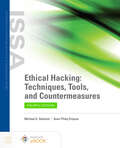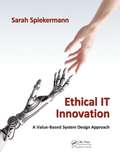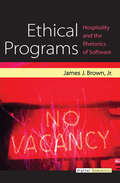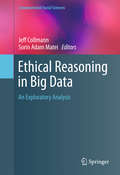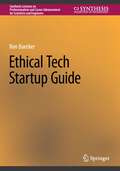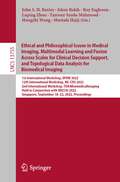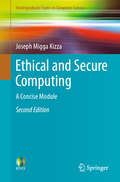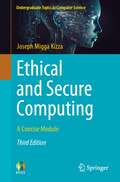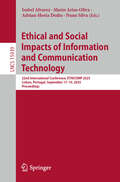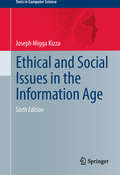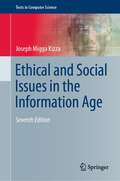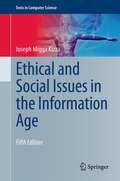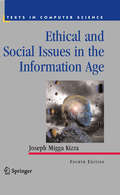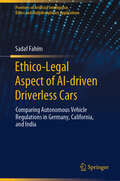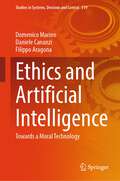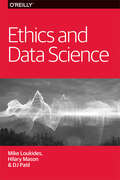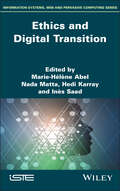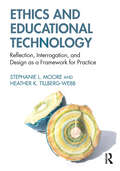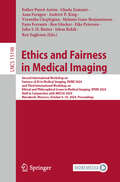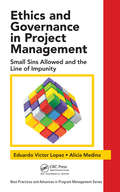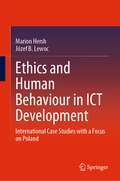- Table View
- List View
Ethical Hacking: Techniques, Tools, and Countermeasures
by Michael G. Solomon Sean-Philip OriyanoEthical Hacking: Techniques, Tools, and Countermeasures, Fourth Edition, covers the basic strategies and tools that prepare students to engage in proactive and aggressive cyber security activities, with an increased focus on Pen testing and Red Teams. Written by subject matter experts, with numerous real-world examples, the Fourth Edition provides readers with a clear, comprehensive introduction to the many threats on the security of our cyber environments and what can be done to combat them. The text begins with an examination of the landscape, key terms, and concepts that a security professional needs to know about hackers and computer criminals who break into networks, steal information, and corrupt data. Part II provides a technical overview of hacking: how attackers target cyber resources and the methodologies they follow. Part III studies those methods that are most effective when dealing with hacking attacks, especially in an age of increased reliance on distributed devices.
Ethical IT Innovation: A Value-Based System Design Approach
by Sarah SpiekermannExplaining how ubiquitous computing is rapidly changing our private and professional lives, Ethical IT Innovation: A Value-Based System Design Approach stands at the intersection of computer science, philosophy, and management and integrates theories and frameworks from all three domains.The book explores the latest thinking on computer ethics, inc
Ethical Programs: Hospitality And The Rhetorics Of Software
by James J. BrownLiving in a networked world means never really getting to decide in any thoroughgoing way who or what enters your "space" (your laptop, your iPhone, your thermostat . . . your home). With this as a basic frame-of-reference, James J. Brown's Ethical Programs examines and explores the rhetorical potential and problems of a hospitality ethos suited to a new era of hosts and guests. Brown reads a range of computational strategies and actors, from the general principles underwriting the Transmission Control Protocol (TCP), which determines how packets of information can travel through the internet, to the Obama election campaign's use of the power of protocols to reach voters, harvest their data, incentivize and, ultimately, shape their participation in the campaign. In demonstrating the kind of rhetorical spaces networked software establishes and the access it permits, prevents, and molds, Brown makes a significant contribution to the emergent discourse of software studies as a major component of efforts in broad fields including media studies, rhetorical studies, and cultural studies.
Ethical Reasoning in Big Data
by Jeff Collmann Sorin Adam MateiThis book springs from a multidisciplinary, multi-organizational, and multi-sector conversation about the privacy and ethical implications of research in human affairs using big data. The need to cultivate and enlist the public's trust in the abilities of particular scientists and scientific institutions constitutes one of this book's major themes. The advent of the Internet, the mass digitization of research information, and social media brought about, among many other things, the ability to harvest - sometimes implicitly - a wealth of human genomic, biological, behavioral, economic, political, and social data for the purposes of scientific research as well as commerce, government affairs, and social interaction. What type of ethical dilemmas did such changes generate? How should scientists collect, manipulate, and disseminate this information? The effects of this revolution and its ethical implications are wide-ranging. This book includes the opinions of myriad investigators, practitioners, and stakeholders in big data on human beings who also routinely reflect on the privacy and ethical issues of this phenomenon. Dedicated to the practice of ethical reasoning and reflection in action, the book offers a range of observations, lessons learned, reasoning tools, and suggestions for institutional practice to promote responsible big data research on human affairs. It caters to a broad audience of educators, researchers, and practitioners. Educators can use the volume in courses related to big data handling and processing. Researchers can use it for designing new methods of collecting, processing, and disseminating big data, whether in raw form or as analysis results. Lastly, practitioners can use it to steer future tools or procedures for handling big data. As this topic represents an area of great interest that still remains largely undeveloped, this book is sure to attract significant interest by filling an obvious gap in currently available literature.
Ethical Tech Startup Guide (Synthesis Lectures on Professionalism and Career Advancement for Scientists and Engineers)
by Ron BaeckerThis book draws on almost five decades of entrepreneurial experience and innovation and offers a broad perspective on ethical tech startups. It approaches the subject on two fronts by considering both the business of ethical technology as well as the challenges of tech startups with an imperative to behave ethically. The book provides readers with the tools to ethically frame and construct their startup ventures whether or not their core business is rooted in a technology meant to serve a social good. Incorporating ethical business practices both in knowledge and action, this book leads readers through the process of shaping an incipient startup idea all the way through the long-term operating stages. Using real-world case studies, the book explores key factors in successfully planning, framing, launching, leading, managing, and financing startups. This book is essential reading for researchers, academics, and students as well as industry professionals who have an idea or technology they want to get out into the world. Whether readers are seasoned in the field, employees of existing startups looking for better approaches, or new idealistic innovators who want to learn where to start, this guidebook explains and explores the road to launching the next great ethical tech startup.
Ethical and Legal Aspects of Computing: A Professional Perspective from Software Engineering (Undergraduate Topics in Computer Science)
by Gerard O'ReganThis textbook presents an overview of the critically important ethical and legal issues that arise in the computing field and provides a professional perspective from software engineering. The author gained exposure to these aspects of computing while working as a software engineer at Motorola in Ireland, where he coordinated the patent programme and worked with several software suppliers. Topics and features: Presents a broad overview of ethics and the lawIncludes key learning topics, summaries, and review questions in each chapter, together with a useful glossaryDiscusses the professional responsibility of computer professionalsExplores ethics in various civilisations and religious traditionsDiscusses ethical software engineering and ethical outsourcingConsiders what is fair and ethical in data scienceDescribes ethical challenges that arise in social media and the AI fieldReviews intellectual property including patents, copyright and trademarks This practical and easy-to-follow textbook/reference is ideal for computer science students seeking to understand legal and ethical aspects of computing. The text also serves as a concise self-study primer for software engineers and software managers.
Ethical and Philosophical Issues in Medical Imaging, Multimodal Learning and Fusion Across Scales for Clinical Decision Support, and Topological Data Analysis for Biomedical Imaging: 1st International Workshop, EPIMI 2022, 12th International Workshop, ML-CDS 2022, 2nd International Workshop, TDA4BiomedicalImaging, Held in Conjunction with MICCAI 2022, Singapore, September 18–22, 2022, Proceedings (Lecture Notes in Computer Science #13755)
by Hongzhi Wang Tanveer Syeda-Mahmood Islem Rekik Luping Zhou Mustafa Hajij John S. H. Baxter Roy EaglesonThis book constitutes the refereed joint proceedings of the 1st International Workshop on Ethical & Philosophical Issues in Medical Imaging (EPIMI 2022); the 12th International Workshop on Multimodal Learning and Fusion Across Scales for Clinical Decision Support (ML-CDS 2022) and the 2nd International Workshop on Topological Data Analysis for Biomedical Imaging (TDA4BiomedicalImaging 2022), held in conjunction with the 25th International Conference on Medical Imaging and Computer-Assisted Intervention, MICCAI 2022, in Singapore, in September 2022.EPIMI includes five short papers about various humanistic aspects of medical image computing and computer-assisted interventions. The ML-CDS papers discuss machine learning on multimodal data sets for clinical decision support and treatment planning. The TDA papers focus on Topological Data Analysis: a collection of techniques and tools that have matured from an increasing interest in the role topology plays in machine learning and data science.
Ethical and Secure Computing: A Concise Module (Undergraduate Topics in Computer Science)
by Joseph Migga KizzaThis engaging textbook highlights the essential need for a strong ethical framework in our approach to computer, information and engineering science. Through thought-provoking questions and case studies, the reader is challenged to consider the deeper implications arising from the use of today’s rapidly-evolving computing technologies and ever-changing communication ecosystems. This updated second edition features new material on information security, intellectual property rights, the Internet of Things, and 5G technologies. Topics and features: introduces a philosophical framework and tools for understanding and analyzing computer ethics in personal, public, and professional spheres; describes the impact of computer technology on issues of security, privacy, anonymity, and civil liberties; examines intellectual property rights in the context of computing, including the risks and liabilities associated with software; discusses such key social issues in computing as the digital divide, employee monitoring in the workplace, and risks to physical and mental health; reviews the history of computer crime, and the threat of digitally facilitated bullying, harassment, and discrimination; considers the ethical challenges arising from online social networks, mobile telecommunications, virtual reality, the Internet of Things, and 5G technologies; includes learning objectives, discussion questions and exercises throughout the book. This concise and accessible work addresses the critical ethical and moral issues important to all designers and users of computer technologies. The text incorporates the latest curricula requirements for undergraduate courses in computer science, and offers invaluable insights into the social impact and legal challenges posed by the latest generation of computing devices and networks.
Ethical and Secure Computing: A Concise Module (Undergraduate Topics in Computer Science)
by Joseph Migga KizzaThis textbook highlights the essential need for a strong ethical framework in our approach to teaching of and working in computer, information and engineering sciences.Through thought-provoking questions and case studies, the reader is challenged to consider the deeper implications arising from the use of today’s rapidly evolving computing technologies and ever-changing communication ecosystems.This thoroughly revised and updated third edition features revised chapters with new and updated content and hardened the ethical framework. To cope with the rapidly changing computing and telecommunication ecosystem, a new chapter, Ethics and Social Responsibility in the Metaverse, has been added. The interface between our current universe and the evolving metaverse presents a security quagmire. The discussion throughout the book is candid and intended to ignite students’ and professionals’ interest and active participation in discussions of the issues we are facing now and those likely to emerge in the near future. Topics and features—including fully updated content:Introduces a philosophical framework and tools for understanding and analyzing computer ethics in personal, public, and professional spheresDescribes the impact of computer technology on issues of security, privacy, anonymity, and civil libertiesDiscusses the security and ethical quagmire in the platforms of the developing metaverse (NEW chapter)Examines intellectual property rights in the context of computing, including the risks and liabilities associated with softwareDiscusses such key social issues in computing as the digital divide, employee monitoring in the workplace, and risks to physical and mental healthReviews the history of computer crime, and the threat of digitally facilitated bullying, harassment, and discriminationConsiders the ethical challenges arising from online social networks, mobile telecommunication technologies, virtual reality, the Internet of Things and 5G technologiesIncludes learning objectives, discussion questions and exercises throughoutThis concise and accessible work addresses the critical ethical and moral issues important to all designers and users of computer technologies. The text incorporates the latest curricula requirements for undergraduate courses in computer science, as well as offers invaluable insights into the social impact and legal challenges posed by the latest generation of computing devices and networks.
Ethical and Social Impacts of Information and Communication Technology: 22nd International Conference, ETHICOMP 2025, Lisbon, Portugal, September 17–19, 2025, Proceedings (Lecture Notes in Computer Science #15939)
by Adrian-Horia Dediu Nuno Silva Isabel Alvarez Mario Arias-OlivaThis book constitutes the refereed proceedings of the 22nd International Conference on Ethical and Social Impacts of Information and Communication Technology, ETHICOMP 2025, held in Lisbon, Portugal, during September 17–19, 2025.The 51 full papers presented in this volume were carefully reviewed and selected from 165 submissions. The papers are organized in the following topical sections: Ethics, Society; Eduction; Systems; and Security.
Ethical and Social Issues in the Information Age
by Joseph Migga KizzaThe frequency of new editions of this book is indicative of the rapid and trem- dous changes in the fields of computer and information sciences. First published in 1995, the book has rapidly gone through three editions already and now we are in the fourth. Over this period, we have become more dependent on computer and telecommunication technology than ever before and computer technology has become ubiquitous. Since I started writing on social computing, I have been ad- cating a time when we, as individuals and as nations, will become totally dependent on computing technology. That time is almost on us. Evidence of this is embodied in the rapid convergence of telecommunication, broadcasting, and computing devices; the miniaturization of these devices; and the ever increasing storage capacity , speed of computation, and ease of use. These qualities have been a big pulling force sucking in millions of new users every day, sometimes even those unwilling. Other appealing features of these devices are the increasing number of applications, apps, as they are increasingly becoming known, and being wireless and easily portable. Whether small or big, these new gizmos have become the c- terpiece of an individual's social and economic activities and the main access point for all information. Individuals aside, computing technology has also become the engine that drives the nations' strategic and security infrastructures that control power grids, gas and oil storage facilities, transportation, and all forms of national communication, including emergency services.
Ethical and Social Issues in the Information Age (Texts in Computer Science)
by Joseph Migga KizzaThis textbook examines the ethical, social, and policy challenges arising from our rapidly and continuously evolving computing technology—ranging from the Internet, over to the cross-platforms consisting of ubiquitous portable and wearable devices to the eagerly anticipated metaverse—and how we can responsibly access and use these spaces. The text emphasizes the need for a strong ethical framework for all applications of computer science and engineering in our professional and personal life.This comprehensive seventh edition features thoroughly revised chapters with new and updated content, hardened by the bedrock ethical and moral values. Because of the rapidly changing computing and telecommunication ecosystem, a new chapter on Ethics and Social Responsibility in the Metaverse has been added. The interface between our current universe and the evolving metaverse presents a security quagmire. The discussion throughout the book is candid and intended to ignite students' interest and participation in class discussions and beyond. Topics and features:Establishes a philosophical framework and analytical tools for discussing moral theories and problems in ethical relativismOffers pertinent discussions on privacy, surveillance, employee monitoring, biometrics, civil liberties, harassment, the digital divide, and discriminationDiscusses the security and ethical quagmire in the platforms of the developing metaverseProvides exercises, objectives, and issues for discussion with every chapterExamines the ethical, cultural and economic realities of mobile telecommunications, computer social network ecosystems, and virtualization technologyReviews issues of property rights, responsibility and accountability relating to information technology and softwareExplores the evolution of electronic crime, network security, and computer forensicsIntroduces the new frontiers of ethics: virtual reality, artificial intelligence, and the InternetThis extensive textbook/reference addresses the latest curricula requirements for understanding the cultural, social, legal, and ethical issues in computer science and related fields, and offers invaluable advice for industry professionals wishing to put such principles into practice.
Ethical and Social Issues in the Information Age (Texts in Computer Science)
by Joseph Migga KizzaThis new edition examines the ethical, social, and policy challenges stemming from computing and telecommunication technology, and mobile information-enabling devices. Features: establishes a philosophical framework and analytical tools for discussing moral theories and problems in ethical relativism; offers pertinent discussions on privacy, surveillance, employee monitoring, biometrics, civil liberties, harassment, the digital divide, and discrimination; examines the new ethical, cultural and economic realities of computer social networks; reviews issues of property rights, responsibility and accountability relating to IT and software; discusses how virtualization technology informs ethical behavior; introduces the frontiers of ethics in VR, AI, and the Internet; surveys the social, moral and ethical value systems in mobile telecommunications; explores the evolution of electronic crime, network security, and computer forensics; provides exercises, objectives, and issues for discussion in every chapter.
Ethical and Social Issues in the Information Age, 4th Edition
by Joseph Migga KizzaThe frequency of new editions of this book is indicative of the rapid and tremendous changes in the fields of computer and information sciences. First published in 1995, the book has rapidly gone through three editions already and now we are in the fourth. Over this period, we have become more dependent on computer and telecommunication technology than ever before and computer technology has become ubiquitous. Since I started writing on social computing, I have been advocating a time when we, as individuals and as nations, will become totally dependent on computing technology. That time is almost on us. Evidence of this is embodied in the rapid convergence of telecommunication, broadcasting, and computing devices; the miniaturization of these devices; and the ever increasing storage capacity , speed of computation, and ease of use. These qualities have been a big pulling force sucking in millions of new users every day, sometimes even those unwilling. Other appealing features of these devices are the increasing number of applications, apps, as they are increasingly becoming known, and being wireless and easily portable. Whether small or big, these new gizmos have become the centerpiece of an individual’s social and economic activities and the main access point for all information. Individuals aside, computing technology has also become the engine that drives the nations’ strategic and security infrastructures that control power grids, gas and oil storage facilities, transportation, and all forms of national communication, including emergency services.
Ethical and Social Issues in the Information Age, 5th Edition
by Joseph Migga KizzaThis new edition examines the ethical, social, and policy challenges stemming from computing and telecommunication technology, and mobile information-enabling devices. Features: establishes a philosophical framework and analytical tools for discussing moral theories and problems in ethical relativism; offers pertinent discussions on privacy, surveillance, employee monitoring, biometrics, civil liberties, harassment, the digital divide, and discrimination; examines the new ethical, cultural and economic realities of computer social networks; reviews issues of property rights, responsibility and accountability relating to IT and software; discusses how virtualization technology informs ethical behavior; introduces the frontiers of ethics in VR, AI, and the Internet; surveys the social, moral and ethical value systems in mobile telecommunications; explores the evolution of electronic crime, network security, and computer forensics; provides exercises, objectives, and issues for discussion in every chapter.
Ethico-Legal Aspect of AI-driven Driverless Cars: Comparing Autonomous Vehicle Regulations in Germany, California, and India (Frontiers of Artificial Intelligence, Ethics and Multidisciplinary Applications)
by Sadaf FahimThis book is a comparative study of the laws and regulations involving legal and ethical issues related to Artificial Intelligence (AI), in particular for self-driving cars or autonomous vehicles (AVs). It identifies, analyzes, and points out such issues via a study of laws and regulations in India, Germany, and California, determining the legal liabilities of designer, developer/programmer, manufacturer, producer, users, or AI in the case of AVs. AV technology is being touted as one that is poised to bring revolution in the mobility ecosystem by lessening the number of accidents and by providing other benefits, such as potential to reduce traffic, increase safety and mobility, lower energy usage and generate free time. Despite having such a potential to shape and transform the future, and involvement of tech-giants like Google, Amazon, Facebook, and Microsoft, regulations around AI and AVs are still on the drawing board stage in many countries, as they grapple on how to address this issue which has both local and global players involved and affects both local and global populace. The book studies and compares the existing and evolving regulations in three different regions to bring out the lacunae, loopholes and best practices. It highlights when AI deserves legal personhood, and when it requires to be granted legal standing. It also points out the civil and criminal legal liabilities arising when AV is involved in an accident, and the ethical issues involved in the deployment of AI. The book goes beyond new regulations to analyze whether challenges and problems arising from AI technology can be addressed within existing civil and criminal laws - procedural and substantive law – or whether a sui generis law on AI technology is required. The analysis and the results showcased here would be highly useful for multi-disciplinary research on the topic. Regulators of both industry and governance would find the contents invaluable in getting a broader picture of the issues and concerns around this topic, along with policy makers would be able to come up with more effective regulations on AI and AVs.
Ethics For The Information Age
by Michael J. QuinnThis book is appropriate for any standalone “computers and society” or “computer ethics” course offered by a computer science, business, or philosophy department, as well as special "modules" in any advanced CS course. In an era where information technology changes constantly, a thoughtful response to these rapid changes requires a basic understanding of IT history, an awareness of current issues, and a familiarity with ethics. Ethics for the Information Age is unique in its balanced coverage of ethical theories used to analyze problems encountered by computer professionals in today’s environment. By presenting provocative issues such as social networking, government surveillance, and intellectual property from all points of view, this market-leading text challenges students to think critically and draw their own conclusions, which ultimately prepares them to become responsible, ethical users of future technologies.
Ethics and Artificial Intelligence: Towards a Moral Technology (Studies in Systems, Decision and Control #519)
by Domenico Marino Daniele Cananzi Filippo AragonaIt is a book made up of questions, some without certain answers, that attempts to open the reader's mind to new and, perhaps, futuristic scenarios. There are two diametrically opposed approaches to artificial intelligence today. On the one hand, there are the techno-pessimists who see only dystopian scenarios and experience technological progress with apprehension, emphasising the dangers, and on the other hand, there are the techno-optimists who, on the other hand, tend to overestimate the positive effects, going so far as to attribute almost thaumaturgic virtues to technological progress. Our approach is meant to be secular and scientific; the risks must not be concealed, nor must they be overestimated, just as the positive aspects must not be emphasised. And, in any case, as in any social phenomenon, the governance of processes and the definition of a system of rules and policies are the aspects that can create advantages or disadvantages and, above all, can determine who are the beneficiaries of the advantages and who have to bear the disadvantages. Like any new technology, this too can be dehumanising, but technology is a tool that depends on how it is used and by whom it is used. that of ethics is, therefore, a fundamental aspect. Therefore, one should neither be a techno-optimist nor a techno-pessimist, but should be aware that governing the economic and social structural changes that the advent of artificial intelligence will cause will be crucial to ensure prosperity for future generations and to avoid negative and even apocalyptic scenarios. So no futurist dystopias! Humanity has so far always been able to govern technological progress, it certainly has the potential to govern what some have called 'the Final Invention', but it will only succeed if it is able to understand the peculiarities of this new process of technological development and give it ethical content.The book provides a thoughtful review of the relationship between artificial intelligenceand ethics, approaching the issue from different perspectives: philosophical, technological, economic and legal. This will be one of the most important issues that Humanity will have to face and resolve.
Ethics and Data Science
by Mike Loukides Dj Patil Hilary MasonAs the impact of data science continues to grow on society there is an increased need to discuss how data is appropriately used and how to address misuse. Yet, ethical principles for working with data have been available for decades. The real issue today is how to put those principles into action. With this report, authors Mike Loukides, Hilary Mason, and DJ Patil examine practical ways for making ethical data standards part of your work every day.To help you consider all of possible ramifications of your work on data projects, this report includes:A sample checklist that you can adapt for your own proceduresFive framing guidelines (the Five C’s) for building data products: consent, clarity, consistency, control, and consequencesSuggestions for building ethics into your data-driven cultureNow is the time to invest in a deliberate practice of data ethics, for better products, better teams, and better outcomes. Get a copy of this report and learn what it takes to do good data science today.
Ethics and Digital Transition (ISTE Invoiced)
by Nada Matta Inès Saad Hedi Karray Marie-Hélène AbelThis book presents a study carried out by the IEEE-SMC French chapter on ethics and digital transformation in industry and society. Based on a survey of researchers in ICT, artificial intelligence (AI), as well as on presentation seminars, this study examines the various aspects that should be considered when assessing ethical principles in approaches to digital transition, particularly with regard to intelligent systems. Considering this, Ethics and Digital Transition presents the main technologies and uses of intelligent systems. Bringing together specialists from various fields, it explores the different dimensions of ethics that should be considered in the development of these systems, from the engineering sciences to law, sociology and philosophy. It also looks at the future challenges of ethics in the digital transition.
Ethics and Educational Technology: Reflection, Interrogation, and Design as a Framework for Practice
by Stephanie L. Moore Heather K. Tillberg-WebbEthics and Educational Technology explores the creation and implementation of learning technologies through an applied ethical lens. The success of digital tools and platforms in today’s multi-faceted learning and performance contexts is dependent not only on effective design and pedagogical principles but, further, on an awareness of these technologies’ interactions with and implications for users and social systems. This first-of-its-kind book provides an evidence-based, process-oriented model for ethics in technology-driven instructional design and development, one that necessitates intentional reflective practice, a critical and theoretically informed interrogation of technology, and a participatory approach to technology design and applications. Rich with real-world ethics examples and design cases, supported by reflection questions and applied activities, and attentive to ethical codes among preeminent educational technology organizations, this is an ideal resource for students, faculty, researchers, and professionals across educational technology, instructional design, learning sciences, learning engineering, organizational training, and other disciplines.
Ethics and Fairness in Medical Imaging: Second International Workshop on Fairness of AI in Medical Imaging, FAIMI 2024, and Third International Workshop on Ethical and Philosophical Issues in Medical Imaging, EPIMI 2024, Held in Conjunction with MICCAI 2024, Marrakesh, Morocco, October 6–10, 2024, Proceedings (Lecture Notes in Computer Science #15198)
by Aasa Feragen Ben Glocker Veronika Cheplygina Enzo Ferrante Islem Rekik Ghada Zamzmi John S. H. Baxter Roy Eagleson Esther Puyol-Antón Andrew P. King Melanie Ganz-Benjaminsen Eike PetersenThis book constitutes the refereed proceedings of the Second International Workshop, FAIMI 2024, and the Third International Workshop, EPIMI 2024, held in conjunction with MICCAI 2024, Marrakesh, Morocco, in October 2024. The 17 full papers presented in this book were carefully reviewed and selected from 21 submissions. FAIMI aimed to raise awareness about potential fairness issues in machine learning within the context of biomedical image analysis. The instance of EPIMI concentrates on topics surrounding open science, taking a critical lens on the subject.
Ethics and Governance in Project Management: Small Sins Allowed and the Line of Impunity (Best Practices in Portfolio, Program, and Project Management #26)
by Eduardo Victor Lopez Alicia MedinaThis book shows executive, project, program, and portfolio managers how ethical behavior can ensure that an organization has proper governance. Improper governance and unethical behavior have led to such well-known financial disasters as Enron and Madoff Investments. The book arms managers with two important tools: Small Sins Allowed (SSA) and Line of Impunity (LoI), which together can be the foundation for renewed and vigorous corporate governance. SSA is a powerful tool that helps managers establish a level above which adherence to ethical standards is expected. LoI aids managers in identifying ethical fault lines that may exist in a company and helps to keep unethical behavior in check.
Ethics and Human Behaviour in ICT Development: International Case Studies with a Focus on Poland
by Marion Hersh Józef B. LewocEthics and Human Behaviour in ICT Development discusses ethics in a professional context and encourages readers to self-assessment of their own behaviour. It provides thought-provoking accounts of the little-known early history of technological development in information and communication technology (ICT) and the automation industry in Poland, with a focus on Wroclaw. The book provides a framework for understanding the relationship between ethics and behaviour, and analyses critically ethical and behavioural issues in challenging workplaces and social contexts. It includes:case studies from around the world, especially Poland, which illustrate the relationships between human behaviour and ethics;biographies of successful Polish ICT and automation leading designers;analysis of case studies of human behaviour and ethics in challenging industrial development and other environments; andillustrative practical applications alongside the theory of human behaviour and ethics. The authors demonstrate the ingenuity of the early Polish designers, programmers and other specialists in overcoming the shortage of components caused by import embargoes to enable Poland to develop its own computer industry. An example of this is Elwro, formerly the largest manufacturer of computers in Poland. The discussion of its growth illustrates the potential of human creativity to overcome problems. The discussion of its fall highlights the importance of ethical approaches to technology transfer and the dangers of a colonialist mentality. The book is designed for engineers, computer scientists, researchers and professionals alike, as well as being of interest for those broadly concerned with ethics and human behaviour.
Ethics and Integrity in Education: Derived from the 9th European Conference on Ethics and Integrity in Academia (Ethics and Integrity in Educational Contexts #9)
by Sarah Elaine Eaton Irene Glendinning Beatriz Antoneita Moya Figueroa Shiva Das SivasubramaniamThis book provides insights on approaches for enhancing ethical practice, professionalism and integrity for future development in academia and beyond. It does so by offering a thorough review of the background and processes to enhance academic integrity in the years of artificial intelligence. The book also explores the future of research integrity and ethics by examining lessons from the past. Ideas from research findings on how to incorporate an integrity culture in continuously changing secondary and higher education are addressed. The chapters are written by international authors who have been working in the fields of integrity sciences, focussing on ways to enhance ethics and integrity amongst students, academics and institutions (including schools). They identify approaches to deter and detect misconduct and discuss the ways to educate academic integrity amongst academic communities. The book addresses best practices from international institutions and how these can be transformed and adopted in different subject areas. Embracing and managing the use of generative artificial intelligence (GenAI) tools in education are key themes throughout. Special attention is given to the ethical use of GenAI, exploring the ways to minimise the misuses via policies and guidelines.
